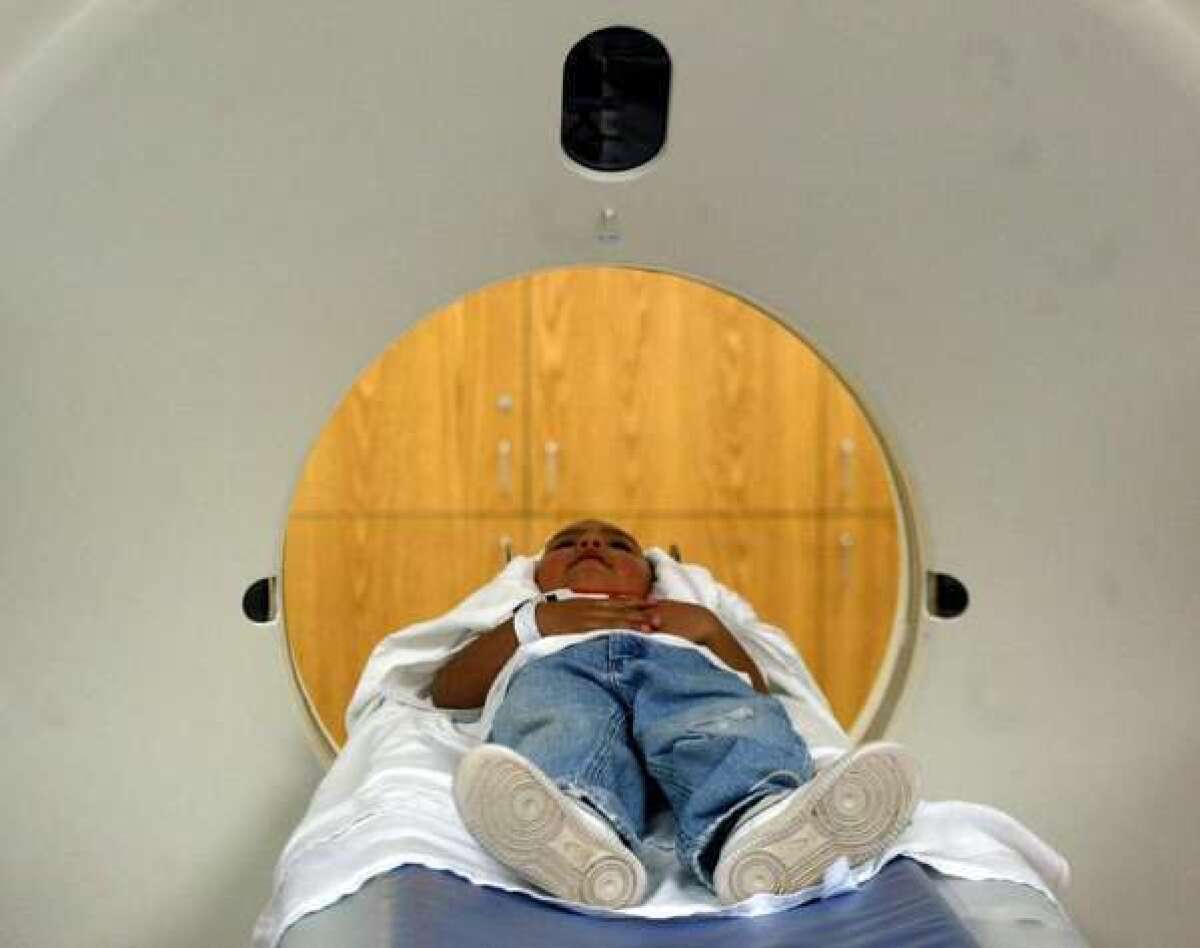Smarter CT scanning of kids would prevent 3,020 cancers each year

- Share via
Approximately 3,020 cancers could be prevented each year if doctors were more judicious about ordering CT scans for kids, according to a new study.
A CT scan is essentially a series of X-rays combined to give physicians a three-dimensional view of a patient’s insides. If there’s a small tumor in the brain, a CT can help doctors find it. Ditto for damage to internal organs after a car accident.
In order to produce clearer pictures, CT scanners use more ionizing radiation than regular X-ray machines -- 100 to 500 times more, according to the authors of the new study. As the American Cancer Society explains:
“Ionizing radiation has enough energy to damage the DNA in cells, which in turn may lead to cancer. … Most scientists and regulatory agencies agree that even small doses of ionizing radiation increase cancer risk, although by a very small amount. In general, the risk of cancer from radiation exposure increases as the dose of radiation increases. Likewise, the lower the exposure is, the smaller the increase in risk. But there is no threshold below which ionizing radiation is thought to be totally safe.”
Children’s growing bodies are particularly sensitive to ionizing radiation. In addition, they have more years ahead of them, giving damaged DNA more opportunity to develop into cancer.
These are some of the reasons why a team of researchers tried to calculate how many cases of cancer could be traced to CT scans performed on children -- and whether that number could be reduced.
Science and Health: Sign up for our email newsletter
The researchers studied records of patients enrolled in several large health plans around the country to estimate the number of CTs done on children ages 15 and younger, as well as the typical dose of radiation associated with those scans. Overall, they found that CT use has roughly doubled since the mid-1990s. The biggest jump was in CT scans of the abdomen and pelvis in kids between the ages of 5 and 14, although scans of the chest, spine and head also increased.
Extrapolating their data to the entire country, the researchers estimated that 4.25 million CT scans are performed on children each year, and those scans will result in 4,870 cancers down the line. In girls, about two-thirds of those cancers would be cases of leukemia or tumors in the breast, thyroid or lung. In boys, about half would be cases of leukemia or cancers of the brain, lung and colon.
Previous studies have estimated that one-third of CT scans in children are medically unnecessary, and if these scans were not done, the number of future cancers would be reduced by one-third, the researchers reported. In addition, if the 25% of scans that used the highest doses of radiation had instead used a more typical amount of radiation (based on the age of the patient and the organ being studied), the number of cancers would fall by 43%. Implementing both changes would result in a 62% drop in future cases of radiation-induced cancers, from 4,870 to 1,850 per year.
The results were published online Monday in JAMA Pediatrics.
The study authors emphasized that children who need CTs should still get them.
“From a patient’s perspective, the benefits of a medically necessary CT scan far exceed the small increase in radiation-induced cancer risk,” they wrote. But they also cited two previous studies that estimated that one-third of CT scans done on children were medically unnecessary. They also noted that safer imaging techniques, such as ultrasound, could be tried before patients were exposed to the ionizing radiation in CT scans.
An editorial that accompanies the study said radiologists are responsible for making sure that tests on children use as little radiation as possible. The authors of the editorial also said the clinicians who treat patients are responsible for making sure the scans they prescribe are medically necessary. For instance, they said, ultrasounds rather than CTs should be used to diagnose a ruptured appendix. Likewise, children who suffer mild traumatic brain injury can be evaluated without using a scanner.
The American College of Radiology, which represents doctors who read CT scans (along with X-rays, ultrasounds, MRIs and other medical imaging studies), urged parents to discuss the pros and cons of CTs with their children’s doctors. CTs “must be used judiciously, when indicated, and when the needed information cannot be obtained in other ways, in order to minimize radiation exposure to all Americans -- particularly children,” the ACR said in a statement.
But they also emphasized that most CTs are done on children involved in accidents or who have other life-threatening conditions that need to be evaluated right away. Overall, “medical imaging exams are directly linked to greater life expectancy, declines in mortality rates, and are generally safer and less expensive than the invasive procedures that they replace,” the ACR’s statement said.
You can read a summary of the study online here and the editorial here. The ACR statement is online here.
Return to Science Now.







